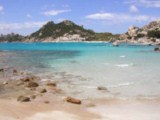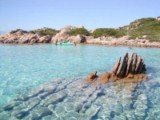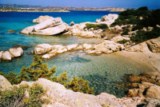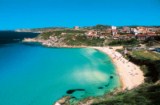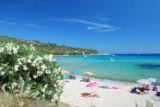|
LA MADDALENA ISLAND & NATIONAL PARK - SARDINIA - SOUTH ITALY
HOTEL ROOMS ACCOMMODATIONS OFFERS IN LA MADDALENA NATIONAL PARK
WHERE TO EAT WHERE TO HAVE FUN EXCURSIONS SPONSORS The Archipelago of La Maddalena, located in the northern part of Sardinia, consists of a set of islands and islets of the landscape and environmental characteristics of particular significance.
62 islands and islets in the large and beautiful winding stretch of sea between the Strait of Bonifacio and the Costa Smeralda. La Maddalena, Caprera, S. Stephen Sprinkle, Budelli, Razzoli, S. Mary, plus a host of islands (including Mortorio, Soffi and Nibani) scattered throughout the most beautiful sea in the Mediterranean and perhaps the world, form an archipelago that is universally considered a masterpiece of nature. Some beaches are among the most famous and evocative of the Mediterranean in particular is reminiscent of the Beach Rose Knight to guts, and the beaches of Cala Coticciu Wreck in Caprera, and Cala Cala Corsara Granara to spread. Unique character to the landscape is given a bays and coves that lead to a myriad of natural harbors very articulated, allowing to find places that can still give safety to mariners in different sea conditions. With regard to the seabed within the archipelago located the Strait of Bonifacio that determines a high hydrodynamics, together with shallow channels and low tidal range, promote extreme clarity of the water with color variations ranging from turquoise, emerald and blue and deep blue. Seabed, are also preserved forms of granite erosion emerged during the last glaciation. The granitic rocks that form the archipelago were originated about 300 million years ago. Raising the Mediterranean following the last glaciation, has separated from Gallura. The coasts have deep bays carved by ancient rivers and small stretches of sand. The granite quarried by water and wind sometimes took strange forms, like the bear of Palau, the head witch Corsara Cove or octopus La Maddalena. This is the largest island and the only one permanently inhabited, is covered by a scenic road and some minor leading to the sea or the hills to the central fortress of the Old Guard (now Meteorological Observatory). Are very suggestive of the Fort Arbuticci and Poggio Rasu Upper made in the nineteenth century. In addition to Maddalena, the largest islands of the archipelago are Caprera (east, with an area of 15.75 sq km and a coastline of 34 km), Budelli, Razzolo, Santa Maria, Spread, Boxing Day. To these are added a myriad of small islands scattered in the sea between the Strait of Bonifacio and the Costa Smeralda. A Caprera (whose highest point is Mount Teialone 212 m high) is accessed by Maddalena through a dam about a mile long and a small bridge. Through pine trees you come to the House of Garibaldi. A dirt road runs through the island of Caprera from south to north through headlands and stretches of scrub mediterraea. To the east, near Punta Coticcio a lighthouse marks the shoal of the monks, where you may spot dolphins. Palau is located opposite the island of Santo Stefano |
||||||||


